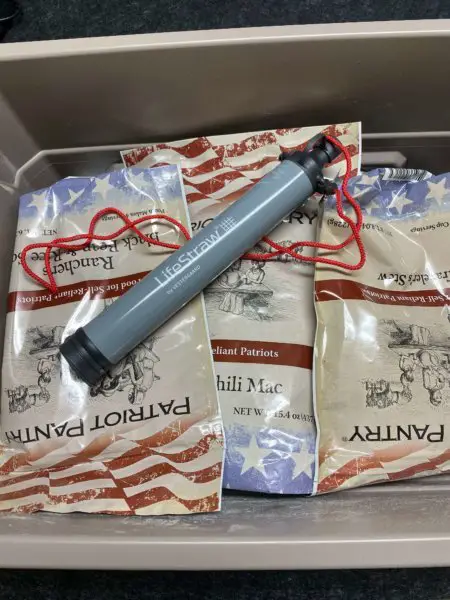If you’re like me, you probably have a couple of survival straws laying around the house. They’re cheap and give you a way to filter water just about anywhere.
Survival straw style filters work to remove a majority of contaminants in water. They can remove 99.9999% of bacteria, 99.9% of protozoa and other contaminants down to .2 microns in size. They are unable to remove viruses, chemicals, and heavy metals.
This makes survival straws one of the best portable water filters out there right now!
Do Survival Straws Work to Filter Water
Waterborne disease is one of the leading killers in the world. Luckily, survival straws offer an option that most people can get access to.
Survival straws have been around for quite a while, with the LifeStraw being the most notable of them. They’re inexpensive and work really well to filter out most of the normal contaminants you’d find in the water.
- Removes Bacteria & Parasites: The Microfiltration Membrane Removes 99.999999% Of Waterborne Bacteria...
- Removes Microplastics: Removes The Smallest Microplastics Found In The Environment (Down To 1...
- Rigorous Testing: All Claims Are Verified With Laboratories Using Standard Testing Protocols Set By...
- Long Lifetime: The Microbiological Filter Will Provide 4,000 Liters (1,000 Gallons) Of Clean And...
- Make An Impact: For Every Lifestraw Product Purchased, A School Child In Need Receives Safe Drinking...
They can filter out things down to .2 microns in size. Which means they remove 99.9999% of bacteria and 99.9% of the protozoa. There are what you’re most likely worried about when you’re just out in the woods trying to get clean water to drink.
It wouldn’t be a great idea to try out a survival straw downstream from an industrial plant, large farm or stagnant water in some third world country.
How Survival Straws Work
Some earlier survival straws relied on chemicals like iodine to disinfect the water. Lately, survival straws like the LifeStraw have gone to a complete physical filtration method.
These straws force the water through a series of hollow fibers that have pores around .2 microns in size. This traps anything larger than that (like bacteria, dirt, and parasites) in the filter and lets the clean water pass through.
This doesn’t filter out the smallest forms of pathogens, viruses. It also doesn’t separate out chemicals from the water.
When you’re done drinking you just blow through the straw to clear it. It’s a simple, yet effective way to get clean water when you’re out and about.
Is a Survival Straw Reusable?
Survival straws are made to be used over and over. They do however eventually need to be replaced.
Check the specific straw that you have to see how many gallons it can filter before it’s no longer good. With the LifeStraw they claim to be able to filter 1,000 gallons of water before you need to replace them.
When Your Survival Straw Runs Out of Life
It’s not always easy to tell exactly when your survival straw runs out of life. If you don’t keep track of how much water you suck through it (how could you) then it’s really a guess as to when you should replace it.
A good rule of thumb is once it becomes more difficult to suck through the straw you should replace it. This means that the filter is getting clogged and you’d be better off with a new one.
Keep in mind that not all survival straws are the same. Some are easy to suck though and others are pretty difficult right from the beginning.
If you’re using a LifeStraw, then you shouldn’t have to suck very hard to get water through it. If you do, replace it.
Can you Drink Pool Water with a Survival Straw?
Pools have chlorine in them to help kill off and disease-causing microbes that may get introduced into them or grow in the water. This makes drinking from a pool potentially dangerous, but not quite as dangerous as you may think.
The EPA says that it’s okay to drink water that has chlorine levels up to 4 parts per million (ppm). Most pools are in the 1-3 ppm level so they should be okay to drink according to the EPA.
I’d suggest using a chlorine tester of some kind before drinking the pool water and then always use a water filter like a survival straw before you ever drink from a pool.

Do Survival Straws Expire?
Survival straws are a filter that physically separates the contamination out of the water so they shouldn’t ever expire if you’re storing them at room temperature in a clean environment.
You may want to check them every once in a while to make sure that nothing unexpected has happened but I can’t really think of anything that you should really be worried about. Store them with any food storage items you may have and they should be good indefinitely until you start using them.
Do Survival Straws Filter Out Giardia?
Some will filter out giardia and some won’t. You’ll need to look into your particular survival filter to find out.
The early version of the LifeStraw didn’t filter out giardia. After some looking around, it seems like the current LifeStraw filters out both giardia and cryptosporidium.
Related Questions
Does the LifeStraw filter viruses? LifeStraws don’t filter viruses. They filter down to .2 microns which gets most bacteria, and parasites but not the viruses. In North America, viruses are rare in natural bodies of water.
How do you clean a LifeStraw? Every time that you use a LifeStraw you should blow air back through the mouthpiece to push all of the water out of the filter. If you have clean water, you should suck some up and then blow through it again. Just don’t stick the dirty filter into clean water you plan to drink.


